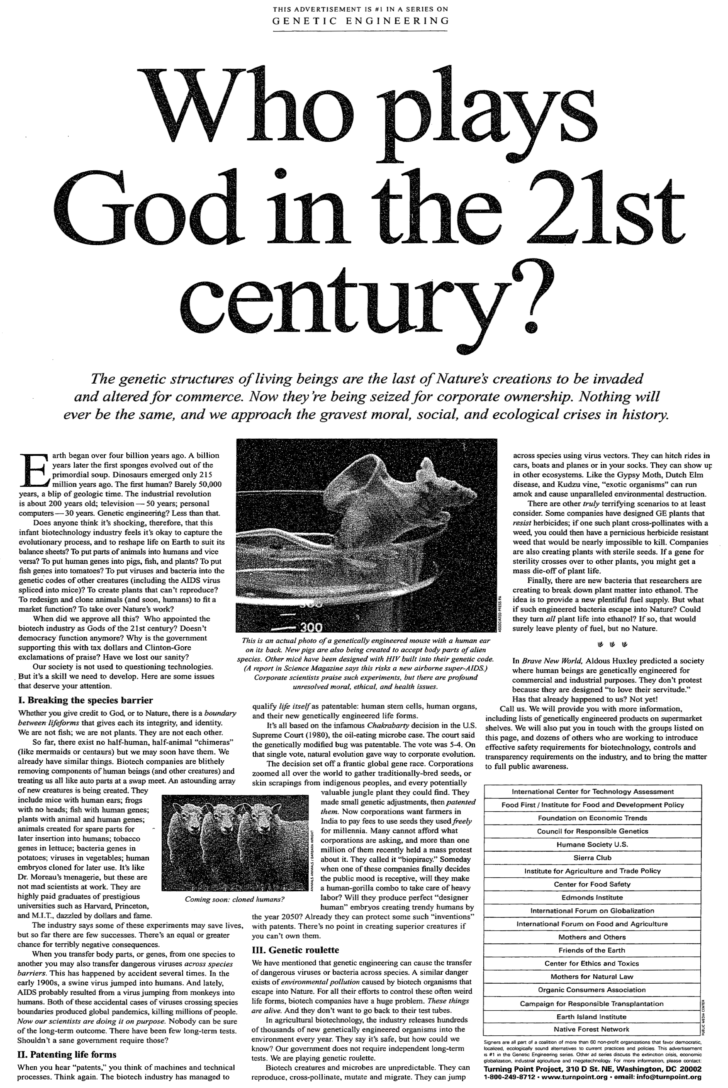Remember back in 1999 when the anti-biotech greens tried to scare us with the full-page newspaper ad below? They were lying and wrong 22 years ago and nothing has changed since. Below is my Washington Times column on this ad from December 10, 1999.

The Green’s Ear-ie Ad
Groups Use Scare Tactics to Fight Technology
By Steven Milloy
Washington Times, December 10, 1999
“Who plays God in the 21st century?” is the rhetorical title of a recent full-page advertisement in the New York Times attacking genetic engineering. The rhetorical reply should be, “Someone who takes more seriously the Ninth Commandment: ‘Thou shalt not bear false witness.’ ”
The Oct. 11 advertisement was the first in a series lambasting genetic engineering, “economic globalization,” “industrial agriculture” and “technomania.” The series is sponsored by The Turning Point Project, a coalition of anti-technology and environmental groups including Greenpeace, the Sierra Club and the U.S. Public Interest Research Group. Ads appear weekly and will continue through Spring 2000.
The “Who plays God?” ad features a photograph of a shaved laboratory mouse with what looks like a human ear attached to its back. The caption states, “This is an actual photo of a genetically engineered mouse with a human ear on its back.”
The text rails against genetic engineering: “The genetic structures of living beings are the last of Nature’s creations to be invaded and altered for commerce… the infant biotechnology industry feels it’s OK to… reshape life on Earth to suit its balance sheets. Who appointed the biotech industry as Gods of the 21st century? So far, there exist no half-human, half-animal ‘chimeras’ (like mermaids or centaurs) but we may soon have them.”
Dramatic language, indeed. But let’s return to that mouse photograph.
In reality, the mouse with the attached “human ear” has nothing to do with genetic engineering. That’s not even a real ear attached to the mouse.
A template in the shape of a human ear was formed and then seeded with human chondrocytes, or cartilage cells. The template was then surgically implanted on the back of a mouse, under its skin. The chondrocytes eventually grew into the structure resembling a child’s ear.
Eventually this technology may help children who are either born without ears or who lose their ears through injury. The advantage of the technique is that tissue grown from a patient’s own cells avoids the problem of rejection.
Thanks to this “tissue engineering,” a “whole host of other lab-grown body parts are just around the corner,” says Dr. Charles Vacanti, an anesthesiologist and director of the Center for Tissue Engineering at the University of Massachusetts Medical Center. “I believe that it’s technically possible at this time to replace any bone or any cartilage lost in an accident – or to disease,” adds Dr. Vacanti.
But nothing in this process involves changing the genetic structure of any living thing. The ad claims that “Biotech companies are blithely removing components of human beings (and other creatures) and treating us all like auto parts at a swap meet. An astounding array of new creatures is being created. They include mice with human ears.”
Of course, if the pictured mouse reproduced, no “new” creature would be created. A normal mouse would result because the mouse’s genetic makeup was not changed.
If the photo has no connection to the topic of the ad, what’s it doing there? Apparently, the Greens will stoop to any level necessary to make their dubious points. Unfortunately, the “Who plays God?” ad is only the tip of the iceberg. Subsequent advertisements haven’t been any more credible.
An ad titled “Genetic Roulette” features a photo of a Monarch butterfly with the caption, “Cornell University scientists discovered that genetically engineered corn pollen killed 50 percent of Monarchs in their test.” The reality is somewhat different. John Losey, the lead Cornell scientist, said in an interview last June, “Our study was conducted in the laboratory and, while it raises an important issue, it would be inappropriate to draw any conclusions about the risk to Monarch populations in the field based solely on these initial results.” Subsequent research by Mr. Losey and others has made premature drawing of conclusions even more inappropriate.
Another ad, titled “Unlabeled, untested – and you’re eating it,” states, “In secret, genetically engineered foods are showing up on American grocery shelves . . . the Food and Drug Administration still does not require labels or safety tests.” Not quite. The Turning Point Coalition is lucky The New York Times doesn’t require truth tests.
A longstanding approval process for genetically modified crops involves the U.S. Environmental Protection Agency, the Department of Agriculture and the FDA. The FDA standard for approving GM foods is whether they are substantially equivalent to non-GM foods. Safety assessment procedures focus on unique or novel components of GM-foods, such as proteins or metabolites. Foods not “substantially equivalent,” but deemed “safe” must be labeled as to what is different.
This regulatory process was subject to notice and public comment prior to adoption. The FDA is currently holding public hearings around the country to determine whether the public wants more involvement. Where’s the big “secret”?
These ads aren’t intended to inform; they’re intended to scare. Who plays God in the 21st century? I’ve got a better question: When will the Greens tell the truth?
Steven J. Milloy is an adjunct scholar with the Cato Institute and publisher of Junkscience.com.